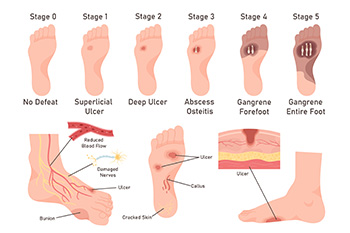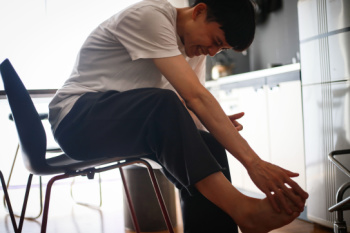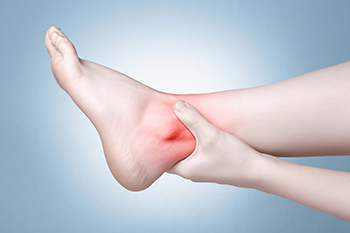Connect With Us
Blog
Items filtered by date: September 2025
Healthy Toenails and Common Problems That Affect Them

Toenails can change for many reasons, and those changes are often more than cosmetic. Thickened or discolored nails may point to fungal infections, while trauma or tight shoes can alter their shape. Ingrown toenails are another common issue, where the edge of the nail presses into the surrounding skin, leading to pain and sometimes infection. Circulation concerns, diabetes, or conditions such as psoriasis can also influence nail health. Treatments depend on the underlying cause. Fungal infections may require antifungal therapy, while ingrown nails might benefit from careful trimming, wearing proper footwear, or professional podiatric care. Additionally, pressure related damage can often be managed with adjustments to shoes and routine nail maintenance. Practicing good hygiene and keeping nails cut straight across helps prevent many problems. If you are experiencing nail changes or painful ingrown nails, it is suggested that you see a podiatrist for appropriate treatment solutions.
Toe pain can disrupt your daily activities. If you have any concerns, contact one of our podiatrists of Advanced Foot and Ankle Centers, Inc.. Our doctors can provide the care you need to keep you pain-free and on your feet.
What Causes Toe Pain?
Most severe toe pain is caused due to a sports injury, trauma from dropping something heavy on the toe, or bumping into something rigid. Other problems can develop over time for various reasons.
Toe pain can be caused by one or more ailments. The most common include:
- Trauma
- Sports injury
- Wearing shoes that are too tight
- Arthritis
- Gout
- Corns and calluses
- Hammertoe
- Bunions
- Blisters
- Ingrown toenails
- Sprains
- Fractures (broken bones)
- Dislocations
When to See a Podiatrist
- Severe pain
- Persistent pain that lasts more than a week
- Signs of infection
- Continued swelling
- Pain that prevents walking
Diagnosis
In many cases the cause of toe pain is obvious, but in others, a podiatrist may want to use more advanced methods to determine the problem. These can range from simple visual inspections and sensation tests to X-rays and MRI scans. Prior medical history, family medical history, and any recent physical traumatic events will all be taken into consideration for a proper diagnosis.
Treatment
Treatments for toe pain and injuries vary and may include shoe inserts, padding, taping, medicines, injections, and in some cases, surgery. If you believe that you have broken a toe, please see a podiatrist as soon as possible.
If you have any questions please contact our offices located in Clovis and Madera, CA . We offer the newest diagnostic and treatment technologies for all your foot and ankle needs.
Reminder: When Was the Last Time...?
Safeguarding the Diabetic Foot from Ulcers

Ulcers of the foot are a common yet preventable concern for people with diabetes. When circulation is reduced and sensation is diminished, even a small blister or cut can turn into a larger problem. The key to prevention lies in daily habits that protect and preserve skin integrity. Washing and drying the feet thoroughly, moisturizing to prevent cracking, and inspecting the toes, soles, and heels each day can make a difference. Choosing shoes that fit well and avoiding barefoot walking also helps to reduce risk. Nail trimming should be done carefully to avoid injury, and any signs of redness or swelling should be addressed early. Routine checkups with a podiatrist are an important layer of protection, since problems may not always be obvious. If you are living with diabetes, it is suggested that you visit a podiatrist regularly to lower your risk of developing foot ulcers.
Diabetic foot care is important in preventing foot ailments such as ulcers. If you are suffering from diabetes or have any other concerns about your feet, contact one of our podiatrists from Advanced Foot and Ankle Centers, Inc.. Our doctors can provide the care you need to keep you pain-free and on your feet.
Diabetic Foot Care
Diabetes affects millions of people every year. The condition can damage blood vessels in many parts of the body, especially the feet. Because of this, taking care of your feet is essential if you have diabetes, and having a podiatrist help monitor your foot health is highly recommended.
The Importance of Caring for Your Feet
- Routinely inspect your feet for bruises or sores.
- Wear socks that fit your feet comfortably.
- Wear comfortable shoes that provide adequate support.
Patients with diabetes should have their doctor monitor their blood levels, as blood sugar levels play such a huge role in diabetic care. Monitoring these levels on a regular basis is highly advised.
It is always best to inform your healthcare professional of any concerns you may have regarding your feet, especially for diabetic patients. Early treatment and routine foot examinations are keys to maintaining proper health, especially because severe complications can arise if proper treatment is not applied.
If you have any questions, please feel free to contact our offices located in Clovis and Madera, CA . We offer the newest diagnostic and treatment technologies for all your foot care needs.
A Trusted Surgical Option for Ingrown Toenails

Ingrown toenails can cause persistent pain, swelling, and infection when the edge of the nail grows into the surrounding skin. While conservative care such as soaking, trimming, or antibiotics may provide temporary relief, some cases require a more lasting solution. One well-established approach is a minor surgical procedure that carefully removes the problem portion of the nail and reshapes the nail bed to prevent it from growing back incorrectly. This method, based on the Winograd technique, has been used for decades and continues to be a reliable option for patients struggling with recurring ingrown toenails. The procedure is performed under local anesthesia in a podiatrist’s office, with patients typically walking out the same day. Recovery is usually quick, and many find lasting comfort after years of discomfort. If ingrown toenails are interfering with daily life, it is suggested that you see a podiatrist for an evaluation and appropriate treatment.
Ingrown toenails can become painful if they are not treated properly. For more information about ingrown toenails, contact one of our podiatrists of Advanced Foot and Ankle Centers, Inc.. Our doctors can provide the care you need to keep you pain-free and on your feet.
Ingrown Toenails
Ingrown toenails occur when a toenail grows sideways into the bed of the nail, causing pain, swelling, and possibly infection.
Causes
- Bacterial infections
- Improper nail cutting such as cutting it too short or not straight across
- Trauma to the toe, such as stubbing, which causes the nail to grow back irregularly
- Ill-fitting shoes that bunch the toes too close together
- Genetic predisposition
Prevention
Because ingrown toenails are not something found outside of shoe-wearing cultures, going barefoot as often as possible will decrease the likeliness of developing ingrown toenails. Wearing proper fitting shoes and using proper cutting techniques will also help decrease your risk of developing ingrown toenails.
Treatment
Ingrown toenails are a very treatable foot condition. In minor cases, soaking the affected area in salt or antibacterial soaps will not only help with the ingrown nail itself, but also help prevent any infections from occurring. In more severe cases, surgery is an option. In either case, speaking to your podiatrist about this condition will help you get a better understanding of specific treatment options that are right for you.
If you have any questions, please feel free to contact our offices located in Clovis and Madera, CA . We offer the newest diagnostic and treatment technologies for all your foot care needs.
5 Signs Your Diabetic Wound Needs Immediate Medical Attention
Five Signs Your Diabetic Wound Needs Immediate Medical Attention
Diabetic foot wounds demand swift attention to prevent serious complications. If you're managing diabetes, it's crucial to know when a wound on your legs or feet needs urgent care. Five warning signs signal the need for professional intervention. By recognizing these signs, you can seek timely treatment at Advanced Foot and Ankle Centers, Inc., enhancing your healing process and reducing the risk of severe issues.
Types of Diabetic Wounds
Diabetic wounds on legs and feet are a frequent concern. These wounds often arise from poor circulation, nerve damage, and a weakened immune system. Ulcers are the most common type, often developing from unnoticed minor injuries or pressure points due to reduced sensation in the feet.
It's vital to keep a close eye on these wounds, as they can worsen quickly without much pain, making them easy to miss. This oversight can lead to serious complications, including infections that might need surgery or even result in limb loss. Knowing where these wounds typically appear (soles, toes, and heels) helps in managing them effectively.
Signs Your Diabetic Wound Requires Urgent Care
Spotting the warning signs of a diabetic wound early can prevent serious health issues. Here are key indicators that need immediate attention:
Increased Pain or Swelling
A sudden rise in pain or swelling around a wound might signal an infection or worsening condition. This is especially concerning for those with diabetic neuropathy because it reduces pain signals. Swelling often means your body is reacting to an infection, so seek medical evaluation promptly.
Unusual Odor or Discharge
Noticeable changes in odor or discharge from a wound are major red flags. These symptoms usually indicate an infection that could spread if not addressed quickly. A foul smell or pus-like discharge suggests bacterial activity, requiring professional care to prevent deeper tissue involvement.
Redness or Warmth Around the Wound
Redness and warmth are typical signs of inflammation, often linked to infections. If the area around the wound becomes redder or warmer, it indicates your body is fighting an infection. Swift medical attention is crucial to stop the infection from spreading.
Slow or No Healing Progress
Wounds that aren't healing as expected might point to issues such as poor circulation or infection. Normally, wounds should gradually improve in size and depth. If there's no progress, consult a healthcare professional to reassess your treatment plan.
Fever or Other Systemic Symptoms
A fever or feeling unwell can mean an infection has spread beyond the wound. Symptoms like fever, chills, or fatigue suggest a more widespread infection. Immediate medical intervention is crucial to prevent further complications.
Recognizing these signs allows you to take action and seek the necessary care to avoid serious health problems.
How Can a Diabetic Wound Heal Faster?
Knowing how to heal diabetic wounds requires a mix of attentive self-care and professional guidance. Keeping wounds clean and covered is essential to prevent infection. Regularly change dressings and use antiseptic solutions as advised by your healthcare provider. Managing blood sugar levels is also crucial, as it supports the body's healing process.
Good nutrition, especially adequate protein and vitamins, plays a significant role in recovery. Staying hydrated and avoiding smoking can further aid healing. Advanced treatments, such as Vaporox therapy available at Advanced Foot and Ankle Centers, Inc., enhance blood flow and reduce risks of infection. Consult a specialist to explore the best treatment options for your condition.
When to Seek Professional Help
Act quickly if you notice any warning signs of a diabetic wound. The team at Advanced Foot and Ankle Centers, Inc., offers comprehensive care tailored to your needs. Their expertise in diabetic foot care ensures targeted treatments that address the root causes of wound issues. If you notice any signs, schedule an appointment. Our dedicated team is ready to assist with personalized treatment plans that prioritize your health. Take the first step towards better health by requesting an appointment today on our website.
When Foot Pain Strikes Suddenly

Gout is a form of arthritis that often affects the joints in the feet, particularly the big toe. Symptoms typically appear suddenly, often at night, and include intense pain, swelling, redness, and warmth in the affected joint. The area may appear shiny and feel extremely tender, even to the touch of a bedsheet. Gout is caused by a buildup of uric acid in the blood, which forms sharp crystals in the joints. Common triggers include diets high in red meat or seafood, excessive alcohol, dehydration, and genetic factors. A podiatrist can diagnose gout through a physical exam, a review of symptoms, and possibly blood tests or joint fluid analysis. Treatment may involve anti-inflammatory medications, dietary changes, lifestyle advice, and, in some cases, medication to reduce uric acid levels. A podiatrist can also help manage recurring flare-ups and long-term joint health. If you are experiencing these symptoms, it is suggested that you schedule an appointment with a podiatrist for appropriate relief and treatment solutions.
Gout is a foot condition that requires certain treatment and care. If you are seeking treatment, contact one of our podiatrists from Advanced Foot and Ankle Centers, Inc.. Our doctors will treat your foot and ankle needs.
What Is Gout?
Gout is a type of arthritis caused by a buildup of uric acid in the bloodstream. It often develops in the foot, especially the big toe area, although it can manifest in other parts of the body as well. Gout can make walking and standing very painful and is especially common in diabetics and the obese.
People typically get gout because of a poor diet. Genetic predisposition is also a factor. The children of parents who have had gout frequently have a chance of developing it themselves.
Gout can easily be identified by redness and inflammation of the big toe and the surrounding areas of the foot. Other symptoms include extreme fatigue, joint pain, and running high fevers. Sometimes corticosteroid drugs can be prescribed to treat gout, but the best way to combat this disease is to get more exercise and eat a better diet.
If you have any questions, please feel free to contact our offices located in Clovis and Madera, CA . We offer the newest diagnostic and treatment technologies for all your foot care needs.
Os Trigonum Syndrome and How It Affects the Ankle

Os trigonum syndrome is a painful condition that occurs when an extra bone at the back of the ankle, called the os trigonum, becomes irritated. This small piece of bone is present in some people and usually does not cause problems. However, repetitive ankle movement, such as pointing the toes during ballet, soccer, or running, can trap this bone between the heel and ankle, leading to pain and swelling. Symptoms often include deep aching at the back of the ankle, tenderness when pressing on the area, and discomfort that worsens with activity. It may be mistaken for other ankle injuries, which is why an accurate diagnosis from a podiatrist is important. Treatment includes rest, anti-inflammatory medication, targeted exercise, or supportive footwear. In more severe cases, surgery to remove the os trigonum can relieve pain and restore ankle function. If you have pain or swelling at the back of your ankle, it is suggested that you schedule an appointment with a podiatrist for a diagnosis and proper treatment.
Ankle pain can have many different causes and the pain may potentially be serious. If you have ankle pain, consult with one of our podiatrists from Advanced Foot and Ankle Centers, Inc.. Our doctors will assess your condition and provide you with quality foot and ankle treatment.
Ankle pain is any condition that causes pain in the ankle. Due to the fact that the ankle consists of tendons, muscles, bones, and ligaments, ankle pain can come from a number of different conditions.
Causes
The most common causes of ankle pain include:
- Types of arthritis (rheumatoid, osteoarthritis, and gout)
- Ankle sprains
- Broken ankles
- Achilles tendinitis
- Achilles tendon rupture
- Stress fractures
- Tarsal tunnel syndrome
- Plantar fasciitis
Symptoms
Symptoms of ankle injury vary based upon the condition. Pain may include general pain and discomfort, swelling, aching, redness, bruising, burning or stabbing sensations, and/or loss of sensation.
Diagnosis
Due to the wide variety of potential causes of ankle pain, podiatrists will utilize a number of different methods to properly diagnose ankle pain. This can include asking for personal and family medical histories and of any recent injuries. Further diagnosis may include sensation tests, a physical examination, and potentially x-rays or other imaging tests.
Treatment
Just as the range of causes varies widely, so do treatments. Some more common treatments are rest, ice packs, keeping pressure off the foot, orthotics and braces, medication for inflammation and pain, and surgery.
If you have any questions please feel free to contact our offices located in Clovis and Madera, CA . We offer the newest diagnostic tools and technology to treat your foot and ankle needs.

